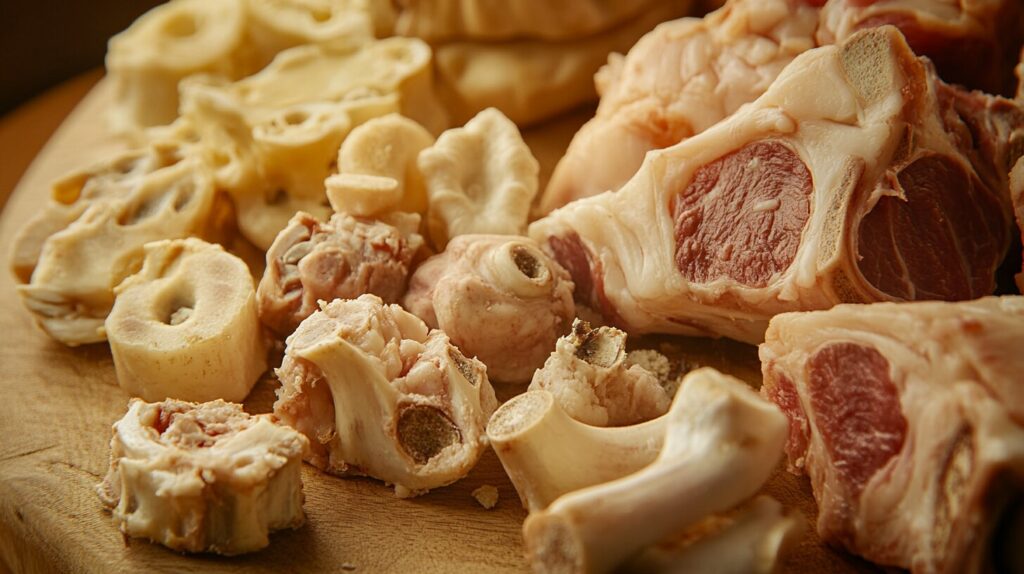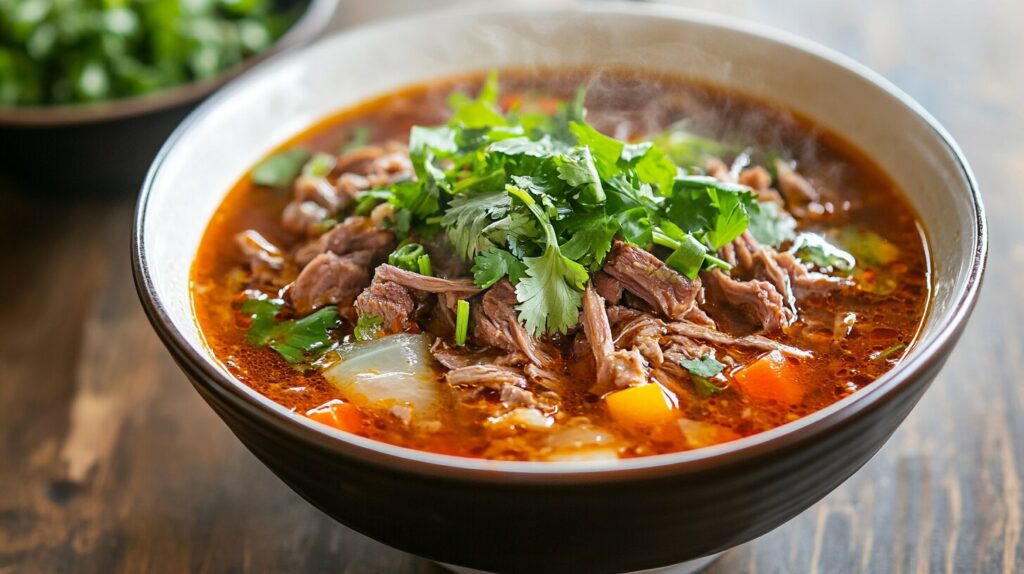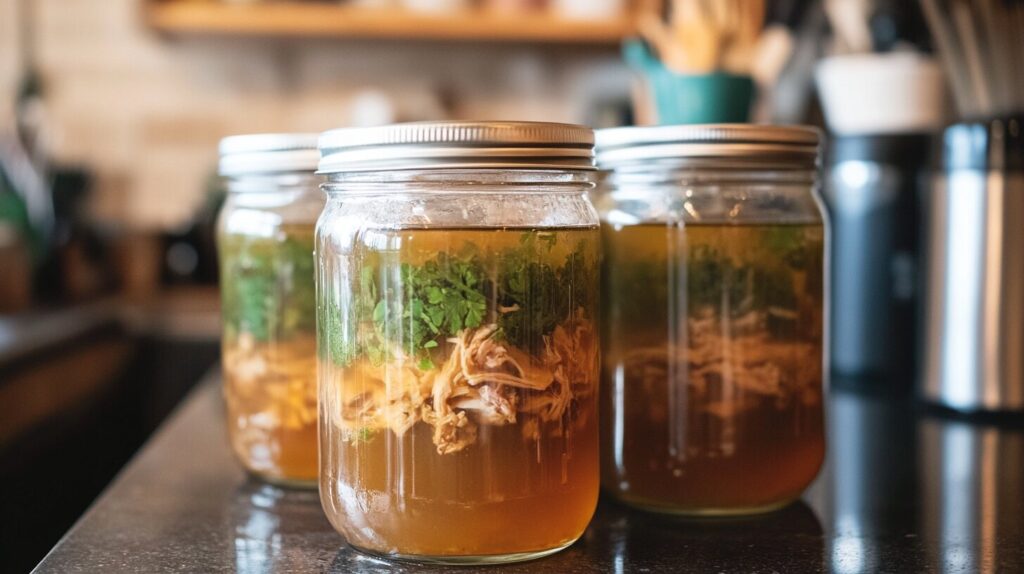
When you hear “soup bones,” you might picture a simmering pot of broth, bubbling away, releasing incredible aromas into the kitchen. But what exactly are soup bones? Well, they’re not just any bones. Soup bones are pieces of bones with some meat, cartilage, and marrow still attached. These bones are often leftover cuts from butchers, perfect for creating rich, flavorful broths and soups.
You might find soup bones labeled as “beef marrow bones,” “knuckle bones,” “oxtail,” or even “neck bones.” They’re packed with nutrients and collagen, which break down into gelatin during cooking. This gelatin gives your broth a thick, luscious texture. And guess what? The meat left on these bones is often tender, juicy, and bursting with flavor — if you know how to handle it!
“Soup bones are like nature’s little treasure chests — they may look humble, but inside, they’re filled with nutrition and flavor waiting to be unlocked.”
Table of Contents
Types of Soup Bones You Can Use
Not all soup bones are created equal, and the type of bones you choose can make a big difference in taste, texture, and the final result. Let’s break down some of the best options.

Beef Soup Bones 🥩
Beef soup bones are a classic choice. They often come from larger cuts like shank, ribs, neck, or even the tail. These bones are ideal for hearty broths and stews. The meat attached to beef soup bones can be quite rich and flavorful, especially when simmered for a long time.
- Flavor Profile: Deep, savory, and umami-rich.
- Best Dishes: Beef barley soup, bone broth, and hearty vegetable stews.
Lamb Soup Bones 🐑
Lamb soup bones might be less common, but they’re incredibly delicious. These bones come from cuts like lamb shank, neck, or ribs. The meat on lamb bones is tender and has a distinctive, slightly gamey flavor. Perfect for those who love a bit of extra character in their soups.
- Flavor Profile: Earthy, rich, and slightly gamey.
- Best Dishes: Traditional lamb stew, Middle Eastern soups, or spiced broths.
Chicken Soup Bones 🍗
Chicken soup bones are often from the carcass or leftover parts like wings, necks, and backs. They’re lighter than beef or lamb bones but still pack a punch of flavor. The meat is usually easy to pull off after simmering, making it perfect for quick and easy meals.
- Flavor Profile: Light, savory, and comforting.
- Best Dishes: Classic chicken soup, shredded chicken broth, or simple noodle soups.
Nutritional Value of Meat from Soup Bones
Many people ask, ‘Can I eat the meat from soup bones?’ The answer is a resounding yes! Eating the meat from soup bones isn’t just about taste — it’s also incredibly nutritious. The long, slow cooking process draws out a ton of goodness from the bones and meat, giving you a nutrient-dense meal.
Protein Powerhouse 💪
The meat from soup bones is rich in protein, the essential building block for your muscles, skin, and organs. Just a few bites of this meat can help fuel your body and keep you feeling full longer. It’s a great addition to your diet, especially if you’re looking to increase your protein intake without breaking the bank.
Collagen and Gelatin Benefits
As the bones and meat simmer, they release collagen, which turns into gelatin. Gelatin is fantastic for your gut, joints, skin, and hair. It helps improve digestion, supports joint health, and can even give your skin a youthful glow. Who doesn’t love a natural beauty boost?
Iron and Minerals
Soup bones, especially beef and lamb bones, are loaded with iron, calcium, magnesium, and phosphorus. These minerals are vital for healthy bones, red blood cell production, and overall well-being. If you’re looking to add a natural boost of nutrients to your diet, meat from soup bones is a smart choice.
“When you eat meat from soup bones, you’re getting a meal that’s not just delicious — it’s a nutrient-packed gift for your body!”
Common Concerns About Eating Meat from Soup Bones
You might be wondering, “Is it really safe to eat the meat from soup bones?” or “What if the meat is too tough?” These are valid concerns, and we’re here to address them all.
Safety of Consuming the Meat
Many people ask, ‘Can I eat the meat from soup bones safely?’ Yes, it is absolutely safe to eat the meat from soup bones — as long as it’s cooked properly. When you simmer bones for soup, the meat gets thoroughly cooked, often for hours. This long cooking process kills any harmful bacteria and makes the meat perfectly safe to eat.
Tip: Always use fresh, high-quality bones from a trusted source to ensure food safety. If the bones have been sitting out too long, the meat may spoil, so freshness is key.
Texture and Flavor Considerations
One common complaint about meat from soup bones is that it can be tough or chewy. This happens if the meat isn’t cooked long enough. The key to tender, melt-in-your-mouth meat is time. Slow-cooking the bones allows the connective tissues to break down, making the meat tender and flavorful.
Flavor Hack: Add herbs, garlic, onions, and a splash of vinegar to your broth. The vinegar helps extract more minerals from the bones while enhancing the meat’s flavor.
How Long to Cook for Tender Meat
Patience is your best friend here. For beef and lamb bones, aim to simmer them for at least 4-6 hours. For chicken bones, 2-3 hours is usually enough. The longer the bones simmer, the more tender the meat will become.
Pro Tip: Use a slow cooker or an Instant Pot to make the process even easier. Set it and forget it, and you’ll come back to a pot full of tender goodness.
How to Properly Extract and Use Meat from Soup Bones
So you’ve simmered your bones, and now it’s time to get that delicious meat off. But how do you do it efficiently?
Boiling Techniques for Tender Meat
If you’re asking yourself, ‘Can I eat the meat from soup bones?’ — you absolutely can! The simplest way to extract the meat is to boil the bones until the meat practically falls off. Here’s a step-by-step guide:
- Simmer the Bones: Place the soup bones in a large pot, cover with water, and add herbs and spices. Simmer for several hours.
- Check the Meat: After a few hours, poke the meat with a fork. If it comes off easily, it’s ready.
- Remove the Bones: Take the bones out of the pot and let them cool slightly.
- Shred the Meat: Use your fingers or a fork to pull the meat off the bones. It should come off easily and be tender.
Slow-Cooking for Maximum Flavor
If you have a slow cooker, you’re in luck. Slow-cooking is one of the best methods for extracting tender meat and flavor from soup bones.
- Add Bones to the Slow Cooker: Place the bones in the cooker with water, veggies, and seasonings.
- Set It Low and Slow: Cook on low for 6-8 hours for beef or lamb, or 4-5 hours for chicken.
- Strain and Shred: Once done, strain the broth and separate the meat from the bones.
“Slow-cooking soup bones is like letting time work its magic — you get meat that’s tender, flavorful, and absolutely irresistible.”
Best Recipes for Using Meat from Soup Bones
Now that you know how to extract that delicious meat, the next step is putting it to good use. The great thing about meat from soup bones is that it’s versatile. Whether you’re in the mood for something hearty, comforting, or packed with flavor, these recipes will deliver every time.
Hearty Beef and Vegetable Soup 🥣
Nothing beats a steaming bowl of beef and vegetable soup on a cold day. This recipe uses the meat from beef soup bones to create a dish that’s both nutritious and satisfying.
Ingredients:
- 2 pounds beef soup bones
- 3 carrots, chopped
- 2 potatoes, diced
- 1 onion, chopped
- 2 cloves garlic, minced
- 1 cup green beans
- 1 cup corn kernels
- Salt and pepper to taste
- 1 teaspoon dried thyme
- 8 cups water or beef broth
Instructions:
- Prepare the Broth: Simmer the beef soup bones in water for 4-6 hours to create a rich broth.
- Extract the Meat: Remove the bones and shred the meat.
- Add Vegetables: In the same broth, add carrots, potatoes, onion, garlic, green beans, and corn. Simmer until veggies are tender.
- Season: Add salt, pepper, and thyme to taste.
- Serve: Add the shredded beef back into the soup and serve hot with crusty bread.

“This soup is like a warm hug for your soul — rich, comforting, and packed with goodness.”
Traditional Lamb Stew 🍲
Lamb stew is a flavorful, hearty dish that showcases the unique taste of lamb soup bones. Perfect for a weekend meal or a cozy night in.
Ingredients:
- 2 pounds lamb soup bones
- 4 potatoes, peeled and diced
- 2 carrots, sliced
- 1 onion, chopped
- 2 cloves garlic, minced
- 2 cups beef or chicken broth
- 1 teaspoon rosemary
- 1 teaspoon thyme
- Salt and pepper to taste
Instructions:
- Make the Broth: Simmer lamb bones in water for 4-5 hours.
- Shred the Meat: Remove the bones and pull off the tender meat.
- Cook Veggies: In a pot, sauté onion and garlic. Add potatoes, carrots, and the shredded lamb.
- Add Broth and Herbs: Pour in broth, rosemary, thyme, salt, and pepper. Let simmer until veggies are tender.
- Serve: Enjoy a bowl of savory stew with a sprinkle of fresh herbs.
Classic Chicken Broth with Shredded Meat 🍵
Simple, nourishing, and classic, chicken broth with shredded meat is perfect for a quick and healthy meal.
Ingredients:
- 2 pounds chicken soup bones (necks, backs, wings)
- 3 celery stalks, chopped
- 3 carrots, sliced
- 1 onion, quartered
- 3 cloves garlic, smashed
- Salt and pepper to taste
- 6 cups water
Instructions:
- Simmer Bones: Place chicken bones in a pot with water, celery, carrots, onion, and garlic. Simmer for 2-3 hours.
- Remove Bones: Take out the bones and shred any meat left on them.
- Season: Add salt and pepper to the broth.
- Serve: Pour the broth into bowls, add shredded chicken, and enjoy with noodles or rice if you like.
Benefits of Eating Meat from Soup Bones
Eating meat from soup bones offers a range of health benefits. Not only is it cost-effective, but it also supports your body in several important ways.
Rich in Essential Nutrients 🥦
Wondering, ‘Can I eat the meat from soup bones?’ Absolutely! The meat and marrow from soup bones are loaded with vitamins and minerals like iron, calcium, and phosphorus. These nutrients support your immune system, keep your bones strong, and help prevent anemia.
Boosts Joint Health 🦵
Soup bones are full of collagen, which breaks down into gelatin when cooked. Gelatin is excellent for joint health, helping to reduce pain and inflammation. Athletes, older adults, or anyone with joint issues can benefit from consuming gelatin-rich broths.
Supports Gut Health 🦠
Gelatin from the bones also helps improve digestion and gut health. It supports the lining of your digestive tract, which can help reduce issues like leaky gut, heartburn, or bloating.
“Your gut will thank you for that bowl of bone broth — it’s like a spa treatment for your insides!”
Promotes Healthy Skin and Hair 💆♀️
Collagen isn’t just for joints; it’s also great for your skin and hair. Regularly consuming meat from soup bones can give you glowing skin, stronger nails, and shinier hair.
Cost-Effective and Sustainable 🌱
Using soup bones is a great way to get the most out of your food. Instead of throwing away leftover bones, you’re turning them into nutritious, flavorful meals. It’s a sustainable practice that reduces waste and saves money.
Potential Downsides and How to Overcome Them
As wonderful as meat from soup bones can be, there are a few challenges to keep in mind.
Addressing Tough Meat Issues
Sometimes, the meat from soup bones can be tough or chewy. The solution? Cook it longer! Slow and low heat is the key to tender meat. Don’t rush the process — let time do its magic.
Quick Tip: Adding a splash of vinegar to your broth can help break down the connective tissues faster.
Avoiding Overcooking the Meat
While simmering bones for broth, there’s a balance between extracting nutrients and overcooking the meat. If you plan to use the meat, check it occasionally and pull it off the bones when it’s tender. You can always continue simmering the bones for the broth after removing the meat.
Who Should Avoid Eating Meat from Soup Bones?
While most people can enjoy the benefits of meat from soup bones, there are a few exceptions.
- People with Gout: High-purine foods like bone broth can sometimes trigger gout flare-ups.
- Those on a Low-Protein Diet: If you’re limiting protein for health reasons, be mindful of your intake.
- Allergies or Sensitivities: Some people might be sensitive to certain types of meat or bone broth. Listen to your body!
Common Myths and Facts About Soup Bones
You’ve probably heard a few things about soup bones that made you scratch your head. Let’s bust some myths and reveal the truth behind these culinary powerhouses.
Myth: Soup Bones Are Only for Making Broth
While it’s true that soup bones are excellent for making broth, they’re not just for that. The meat attached to these bones is flavorful, tender (when cooked right), and perfect for a variety of dishes like soups, stews, and even tacos.
Myth: The Meat from Soup Bones Isn’t Nutritious
Some people believe that the meat left on soup bones is inferior or lacks nutrients. Nothing could be further from the truth! The meat is often rich in protein, iron, and essential amino acids. Plus, the long cooking process helps extract even more nutrients.
“Think of soup bones as the gift that keeps on giving — broth, meat, and nutrition all in one!”
Myth: Boiling Bones Destroys All the Nutrients
Some worry that boiling bones for long periods destroys nutrients. In reality, simmering bones and meat actually helps release nutrients like minerals, collagen, and amino acids into the broth. The key is simmering rather than boiling vigorously, which can break down delicate nutrients.
How to Store and Reuse Soup Bones
So, you’ve made a delicious broth and enjoyed the meat, but what about leftovers? Proper storage is essential for getting the most out of your soup bones.

Refrigerating Leftover Soup Bones 🥶
If you plan to use your soup bones within a few days, store them in the refrigerator. Place the bones in an airtight container or a resealable plastic bag.
- Shelf Life: Up to 3-4 days.
- Tip: If the bones have been cooked, keep them submerged in a little broth to maintain moisture.
Freezing Soup Bones ❄️
For longer storage, freezing is the way to go. Both raw and cooked bones freeze well.
- Cool Completely: Let the bones cool to room temperature before freezing.
- Wrap Tightly: Use plastic wrap, freezer bags, or airtight containers.
- Label and Date: Always label your bags to know what you’ve got and when you froze it.
- Shelf Life: Up to 6 months in the freezer.
- Reheating Tip: Thaw in the fridge overnight or add directly to soups and stews while cooking.
Reusing Bones for Multiple Batches of Broth 🔄
Believe it or not, you can reuse soup bones for a second or even third batch of broth! Each round may yield a lighter broth, but it’s still nutrient-rich.
- Simmer Again: After your first broth, strain the liquid and store the bones.
- Add Fresh Veggies: For a second batch, add fresh veggies, herbs, and water.
- Extend Cooking Time: Simmer longer the second time to extract remaining nutrients.
“Reusing soup bones is like getting an encore from your favorite dish — why let good flavor go to waste?”
FAQs About Eating Meat from Soup Bones
Is It Safe to Eat the Meat After Long Boiling?
Yes, absolutely! Long boiling makes the meat tender and thoroughly cooked, eliminating harmful bacteria. Just ensure the bones and meat come from a reliable source.
How Do I Know If the Meat Is Still Good to Eat?
Check the smell, color, and texture. If the meat smells off, feels slimy, or has an unusual color, it’s best to discard it. Fresh meat should have a clean, savory smell and a firm texture.
Can I Freeze Soup Bones with Meat Left on Them?
Yes, you can! Freezing soup bones with meat on them is a great way to preserve them for future use. Just make sure they’re cooled completely and stored in airtight containers or freezer bags.
How Long Should I Simmer Soup Bones for the Best Flavor?
For beef and lamb bones, simmer for 4-6 hours or longer. For chicken bones, 2-3 hours is usually sufficient. The longer you simmer, the more flavor and nutrients you’ll extract.
Can I Use Soup Bones in an Instant Pot or Pressure Cooker?
Yes, using an Instant Pot or pressure cooker can significantly reduce cooking time while still delivering flavorful broth. For beef or lamb bones, cook on high pressure for 1-2 hours. For chicken bones, 30-45 minutes is enough.
Do Soup Bones Add Fat to the Broth?
Yes, soup bones (especially beef and lamb) add fat to the broth. If you want a leaner broth, chill it after cooking and skim off the solidified fat from the top.
Final Thoughts on Eating Meat from Soup Bones
So, can you eat the meat from soup bones? Absolutely! Not only is it safe, but it’s also a tasty, nutritious, and budget-friendly way to make the most out of your ingredients. Still asking, ‘Can I eat the meat from soup bones?’ The answer is yes! Soup bones are nature’s gift that keeps on giving — rich in flavor, nutrients, and endless culinary possibilities.
Whether you’re simmering a pot of beef and vegetable soup, enjoying a hearty lamb stew, or sipping on classic chicken broth, the meat from soup bones adds depth, richness, and health benefits to your meals. Don’t let these humble bones fool you — they’re a powerhouse of flavor and goodness.
“Soup bones are like the underdog of the culinary world — often overlooked but packed with potential and flavor.”
So next time you’re at the butcher or grocery store, don’t hesitate to grab some soup bones. Your taste buds and your body will thank you. Happy cooking! 🍲😊
Explore More Delicious and Informative Recipes 🍲
If you enjoyed learning about the hidden treasures of meat from soup bones, there’s a whole world of delicious and practical recipes to explore! Discover more beef insights with our comprehensive guide, Understanding Beef Tips 🥩. Not sure how stew meat compares to beef tips? Check out Stew Meat vs. Beef Tips: Differences and Uses for all the details you need. And if you’re diving into more bone-based cooking, don’t miss our handy guide on Everything You Need to Know About Soup Bones. These resources will take your cooking game to the next level! ✨
